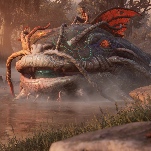Final Fantasy: Type-0 HD: Cutie Roulette

Somebody spilled a little Harry Potter into my Final Fantasy. Type-0, originally released in 2011 as a Japanese-only PSP game, has finally hit the states in the form of an HD remake for the PlayStation 4 and the Xbox One. I expected impressive haircuts, angst and live-action tactical battles—but I didn’t realize that this game would be about teenagers coming of age and navigating high school foibles in between battles.
The juxtaposition of teen drama tropes alongside the more self-serious tone of Type-0’s cut-scenes strikes an odd balance; if the whole game was about cute youngsters hooking up and battling monsters, it might draw favorable comparisons to the Persona series, but Type-0 falters a bit by refusing to commit to its best ideas. The game opens with a frustratingly long series of cut-scenes in which reams of exposition get delivered by not one but two separate voice-over actors. Every chapter or so, Type-0 cuts away to Ken Burns-esque sequences in which historical narrative about the game’s world is delivered over still shots of mystical battles and dictators with furrowed brows. These cut-scenes seem intended to add a layer of self-serious weight to the game’s proceedings, but there’s no really need. In 2011, a game about teens risking their lives on the battlefield might have felt like it needed a lot of set-up, but in 2015? We’ve all seen The Hunger Games.
Feel free to skip the equally laborious opening story scene in which a teenaged boy takes a full ten minutes to bleed out on a battlefield while telling his friends a tortured goodbye. I promise, the game will get better—although you do need to have a soft spot for sad teens. All you need to know is that this is a world where high schoolers with magical powers have been enlisted to fight in the army … alongside adult soldiers, whom they are expected to command. What’s more, these teens have been brainwashed by the system; their memories of their families and their fallen friends are repeatedly wiped, which allows them to fight without being deterred by pesky problems like grieving or PTSD. It’s a fascinating premise for a story about characters so young—and given the high school setting, it makes sense that Square Enix issued a prank version of this game in 2012 that re-cast the characters in a dating sim. (I would have played that version of the game instead, just as happily, but no matter.)
There are a lot of protagonists to keep up with in this game: six boys and six girls. To myself, I jokingly referred to them as a super-group band called “Class Zero,” but as the game went on, I realized that was probably the intended read on our heroes, given how the other characters at their high school treat them. There are narrative reasons as to why Class Zero is both respected and resented by the other classes at Akademia (yes, that really is the name of their home base), but all that matters is that these twelve adorable kiddos are the hottest group on campus and the strongest fighters on the field. Most of them are also the adoptive kids of the school’s resident sexy librarian, Dr. Arecia Al-Rashia. (Hmm, maybe I should be comparing this franchise to Twilight, not Harry Potter?)
Twelve is a high number of characters to keep track of, both in terms of their personalities and their combat mechanics. I think the game would’ve worked just as well with a group of eight, but I made do with twelve by thinking about my heroes as a collection of Pokémon. Just like Pokémon, I had to shuffle all twelve fighters by position and rank, ensuring that different sets of teens would go into battle in different formations so I could level each of them up at the same relative rate and also keep my party balanced. (Speaking of shuffling, the characters are meant to be reminiscent of a deck of cards; for example, four of them are named Ace, Jack, Queen and King. Ace’s weapon of choice is throwing cards, Gambit-style. It’s corny—but it’s also pretty cute.) Keeping track of whose weapons needed upgrades, whose spells needed swapping, and whose gear needed a tune-up felt like a real chore at times. All the same, I know that this type of micro-managing is super-fun for some, and those are the folks who will enjoy this game the most.
There are multiple types of battles to fight; my favorite were the most straightforward action fights, in which you choose three fighters and swap seamlessly between them, locking on to enemies and collecting whatever goodies they drop in turn. (I did think locking on would’ve felt better if it had been with the left trigger instead of the right one, but there’s no option to change this in the settings, so I just had to deal.) Before every mission, I’d also have to select fighters for my “reserve” unit; if any member in my active trio died on the field, a reserve would pop in to help finish the job. Since the fights are live rather than turn-based, they demand quick reflexes just as much as tactical strategizing; for example, enemies’ reticles flash either red or yellow when they are in the midst of an attack motion, and if I could manage a quick enough counter-attack during that window, I’d deal the most damage. Ordinarily, fights in RPGs get boring for me after a while, but Type-0 has a lot of fighters on offer and enough variation in enemy types that it took a while before the grind started to wear me down.
-

-

-

-

-

-

-

-

-

-

-

-

-

-

-

-

-

-

-

-

-

-

-

-

-

-

-

-

-

-

-

-

-

-

-

-

-

-

-

-









































